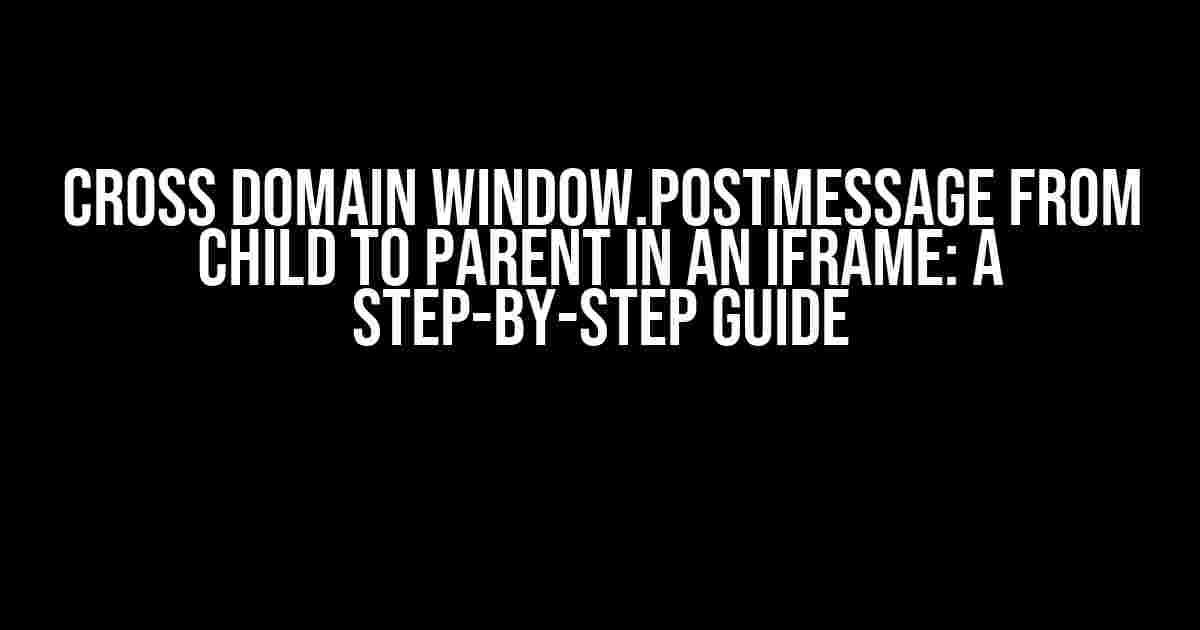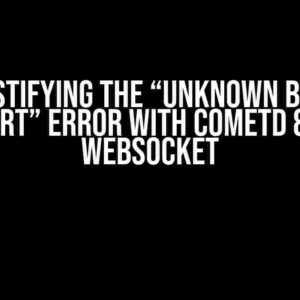Are you stuck trying to communicate between an iframe and its parent page across different domains? Worry no more! In this article, we’ll delve into the world of cross-domain window.postMessage and explore how to send messages from a child iframe to its parent page.
What is window.postMessage?
window.postMessage is a JavaScript method that enables web pages to communicate with each other, even if they’re from different domains. This method is a part of the HTML5 specification and is supported by most modern browsers.
Why do we need cross-domain communication?
In today’s web development landscape, it’s common to have iframes embedded in web pages, often from different domains. Think of social media widgets, third-party APIs, or even online advertisements. Without cross-domain communication, these iframes would be isolated from the parent page, making it difficult to share data or synchronize actions.
The Problem: Cross-domain iframe communication
By default, the same-origin policy restricts web pages from accessing or modifying content from a different domain. This means that an iframe from a different domain cannot directly communicate with its parent page.
The Solution: window.postMessage to the rescue!
window.postMessage allows us to bypass the same-origin policy by sending a message from the iframe to the parent page. This message can contain data, and the parent page can listen for these messages using the message event.
Setting up the Environment
Before we dive into the code, let’s set up a simple scenario to demonstrate cross-domain communication:
- Create a parent page (
parent.html) onhttp://example.com. - Create a child iframe (
child.html) onhttp://iframe.example.net. - Embed the child iframe in the parent page using an iframe tag.
<iframe src="http://iframe.example.net/child.html" frameborder="0" width="100%" height="500"></iframe>Sending a Message from the Child iframe
In the child iframe (child.html), we’ll use the window.postMessage method to send a message to the parent page:
script>
function sendMessage() {
// Get the parent window reference
var parentWindow = window.parent;
// Create a message to send to the parent
var message = { type: 'hello', data: 'Hello from the iframe!' };
// Use window.postMessage to send the message
parentWindow.postMessage(JSON.stringify(message), '*');
}
</script>In this example, we’re sending a JSON-serialized message object with a type and data property. The ‘*’ in the postMessage method specifies that the message can be received by any domain.
Receiving the Message in the Parent Page
In the parent page (parent.html), we’ll add an event listener to listen for messages from the child iframe:
script>
window.addEventListener('message', function(event) {
// Check the origin of the message (optional)
if (event.origin !== 'http://iframe.example.net') {
return;
}
// Parse the received message
var message = JSON.parse(event.data);
// Handle the message based on its type
switch (message.type) {
case 'hello':
console.log(message.data);
break;
default:
console.log('Unknown message type');
}
});
</script>In this example, we’re listening for the message event on the window object. When a message is received, we check the origin of the message to ensure it comes from the expected domain. Then, we parse the received message and handle it based on its type.
Security Considerations
When using window.postMessage, it’s essential to consider security implications:
- Validate the message origin**: Always check the origin of the message to ensure it comes from a trusted domain.
- Validate the message data**: Sanitize and validate the received message data to prevent XSS attacks.
- Use a specific target origin**: Instead of using ‘*’, specify a specific target origin in the postMessage method to restrict the message recipient.
Common Issues and Troubleshooting
Here are some common issues you might encounter when using window.postMessage:
| Issue | Solution |
|---|---|
| Message not being sent or received | Check the same-origin policy, ensure the iframe is properly loaded, and verify the message event listener is attached. |
| Message data not being parsed correctly | Verify the JSON serialization and parsing, and ensure the message data is correctly formatted. |
| SecurityError: Blocked a frame with origin from accessing a cross-origin frame | Check the target origin in the postMessage method, and ensure the iframe domain is allowed in the Content Security Policy (CSP). |
Conclusion
Cross-domain window.postMessage is a powerful tool for communicating between iframes and parent pages from different domains. By following the steps outlined in this article, you should be able to send messages from a child iframe to its parent page, even across different domains.
Remember to validate the message origin and data, and take necessary security precautions to prevent potential security risks.
Happy coding!
This article has provided a comprehensive guide to cross-domain window.postMessage from a child iframe to its parent page. By mastering this technique, you’ll be able to build more robust and interactive web applications that communicate seamlessly across domains.
Originally published at https://example.com/blog
Tags: cross-domain, iframe, window.postMessage, JavaScript, HTML5
Frequently Asked Question
Got questions about cross-domain window.postMessage from child to parent in an iframe? We’ve got answers!
What is the purpose of using window.postMessage?
Window.postMessage is a method that allows scripts from different origins to communicate with each other. It’s especially useful when you need to send data from an iframe to its parent page, even if they’re from different domains.
How do I send a message from the child iframe to the parent window?
To send a message from the child iframe to the parent window, you can use the following code: `parent.window.postMessage(‘Hello from iframe!’, ‘*’);`. The `*` wildcard specifies that the message should be sent to all origins, but you can replace it with a specific domain if needed.
How does the parent window receive the message from the iframe?
To receive the message in the parent window, you need to add an event listener to the `message` event. Here’s an example: `window.addEventListener(‘message’, function(event) { console.log(event.data); });`. This code will log the received message to the console.
What kind of data can be sent using window.postMessage?
You can send any kind of data that can be serialized, such as strings, numbers, objects, and even arrays. However, it’s essential to note that the data is serialized using the structured clone algorithm, which means that some types of data (like functions and errors) cannot be sent.
Are there any security considerations when using window.postMessage?
Yes, there are security considerations when using window.postMessage. You should always validate the origin of the sender and verify the integrity of the received data to prevent cross-site scripting (XSS) attacks. Additionally, be cautious when using the `*` wildcard, as it allows messages to be sent to all origins.




